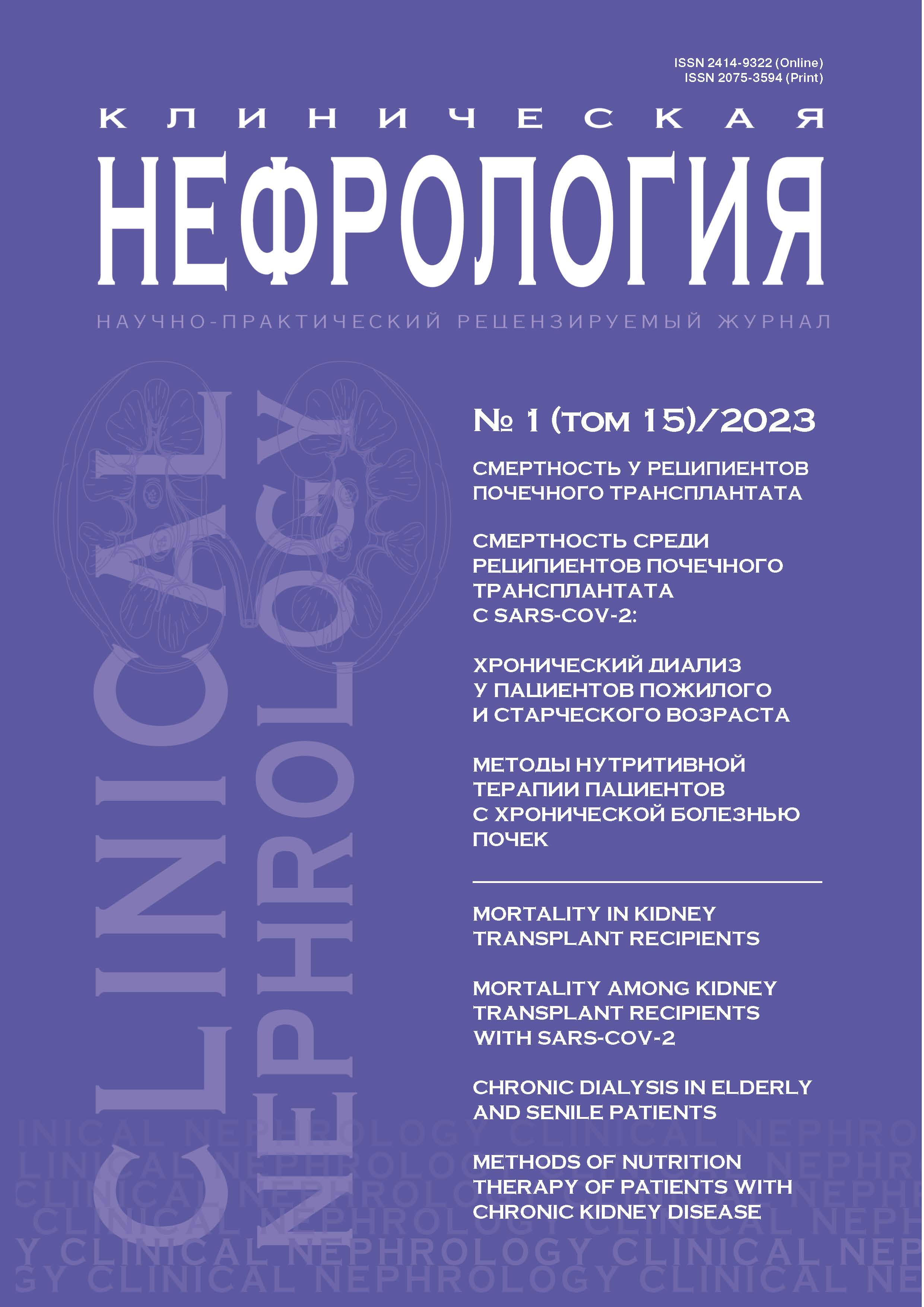Хронический диализ у пациентов пожилого и старческого возраста: выживаемость и факторы, влияющие на исход. Опыт одного центра
- Авторы: Курилович К.А.1,2, Комиссаров К.С.3, Красько О.В.4
-
Учреждения:
- УЗ «1-я городская клиническая больница»
- ГУО «Белорусская медицинская академия последипломного образования»
- ГУ «Минский научно-практический центр хирургии, трансплантологии и гематологии»
- ГНУ «Объединенный институт проблем информатики Национальной академии наук Беларуси»
- Выпуск: Том 15, № 1 (2023)
- Страницы: 58-64
- Раздел: Оригинальные статьи
- URL: https://journals.eco-vector.com/2075-3594/article/view/430430
- DOI: https://doi.org/10.18565/nephrology.2023.1.58-64
- ID: 430430
Цитировать
Полный текст
Аннотация
Цель исследования: оценить выживаемость и изучить предикторы летального исхода (ПЛИ) у пациентов ≥60 лет на хроническом диализе (ХД).
Материал и методы. Анализ данных 199 пациентов ≥60 лет на ХД: 183 (92%) – на программном гемодиализе (ПГД), 16 (8%) – на постоянном амбулаторном перитонеальном диализе (ПАПД).
Результаты. Медиана выживаемости составила 279 дней на ПГД, 650 – на ПАПД, 1-летняя выживаемость на ПГД – 46,5±3,8%, на ПАПД – 81,2±9,8%, 2-летняя выживаемость на ПГД – 33,3±3,9%, на ПАПД – 37,2±13%. Однофакторный анализ ПЛИ: метод ПГД vs ПАПД (отношение рисков [ОР]=1,9, 95% доверительный интервал [ДИ]: 1,04–3,6), возраст [ОР]=1,7, 95% ДИ: 1,1–2,6), наличие сахарного диабета 2 типа – СД2 (ОР=1,5, 95% ДИ: 1,1–2,2), наличие гипергидратации (ОР =1,7, 95% ДИ: 1,2–2,4), додиализные уровни креатинина (Кр; ОР=1,1, 95% ДИ: 1,03–1,2) и мочевины (ОР=1,04, 95% ДИ: 1,02–1,05). Многофакторный анализ ПЛИ: возраст, в первый год лечения: Кр>1000 мкмоль/л, мочевина >45 ммоль/л, начало заместительной почечной терапии (ЗПТ) методом ПГД.
Заключение. Пик смертности пожилых пациентов приходится на первый год ПГД. ПАПД может рассматриваться как ЗПТ 1-й линии у пациентов ≥60 лет. Требуется дальнейшее изучение ПЛИ для улучшения выживаемости первого года пациентов на ЗПТ.
Ключевые слова
Полный текст
Об авторах
Кристина Александровна Курилович
УЗ «1-я городская клиническая больница»; ГУО «Белорусская медицинская академия последипломного образования»
Автор, ответственный за переписку.
Email: cn@bionika-media.ru
ORCID iD: 0000-0002-9112-4863
Белоруссия, Минск; Минск
Кирилл Сергеевич Комиссаров
ГУ «Минский научно-практический центр хирургии, трансплантологии и гематологии»
Email: cn@bionika-media.ru
ORCID iD: 0000-0002-2648-0642
Белоруссия, Минск
Ольга Владимировна Красько
ГНУ «Объединенный институт проблем информатики Национальной академии наук Беларуси»
Email: cn@bionika-media.ru
ORCID iD: 0000-0002-4150-282X
Белоруссия, Минск
Список литературы
- Chan C.T., Blankestijn P.J., Dember L.M., et al. Dialysis initiation, modality choice, access, and prescription: conclusions from a Kidney Disease: Improving Global Outcomes (KDIGO) Controversies Conference. Kidney Int. 2019;96(1):37–47. doi: 10.1016/j.kint.2019.01.017.
- Ageing [Electronic resource]/United Nations. Mode of access: https://www.un.org/en/global-issues/ageing. Date of access: 24.01.2023.
- Santos J., Oliveira P., Malheiro J., et al. Predicting 6-month mortality in incident elderly dialysis patients: a simple prognostic score. Kidney Blood Press. Res. 2020;45:38–50. doi: 10.1159/000504136.
- Inker L.A., Eneanya N.D., Coresh J., et al. New creatinine- and cystatin C-based equations to estimate GFR without race assessment of optimally selected prognostic factors. N. Engl. J. Med. 2021;385:1737–49. doi: 10.1056/NEJMoa2102953.
- Nuttall F.Q. Body mass index: obesity, BMI, and health: A Critical Review. Nutr. Today. 2015;50(3):117–28. doi: 10.1097/NT.0000000000000092.
- Segall L., Nistor I., Van Biesen W., et al. Dialysis modality choice in elderly patients with end-stage renal disease: a narrative review of the available evidence. Nephrol. Dial. Transplant. 2017;32(1):41–9. doi: 10.1093/ndt/gfv411.
- Song Y.H., Cai G.Y., Xiao Y.F., et al. Risk factors for mortality in elderly haemodialysis patients: a systematic review and meta-analysis. BMC. Nephrol. 2020;21(1):377. doi: 10.1186/s12882-020-02026-x.
- Silva A.T., Hauschild D.B., Oliveira L.D. de A., et al. Association of hyperhydration evaluated by bioelectrical impedance analysis and mortality in patients with different medical conditions: Systematic review and meta-analyses. Clin. Nutrit. ESPEN. 2018;28:12–20. doi: 10.1016/j.clnesp.2018.08.022.
- Zemaitis M. R., Foris L. A., Katta S., et al. Uremia. Treasure Island (FL): StatPearls Publish. 2022.
- García G.G., Iyengar A., Kaze F., et al. Sex and gender differences in chronic kidney disease and access to care around the globe. Semin. Nephrol. 2022;42(2):101–13. doi: 10.1016/j.semnephrol.2022.04.001.
- Maddux D. Sex Differences in Chronic Kidney Disease [Electronic resource]/Fresenius Medical Care. Mode of access: https://fmcna.com/insights/articles/sex-differences-chronic-kidney-disease. Date of access: 24.01.2023.
- You A.S., Kalantar-Zadeh K., Obi Y., et al. Residual urine output and mortality in a prospective hemodialysis cohort. Kidney Int. Rep. 2020;5(5):643–53. doi: 10.1016/j.ekir.2020.02.002.
- Wachterman M.W., O’Hare A.M., Rahman O., et al. One-year mortality after dialysis initiation among older adults. JAMA. Intern. Med. 2019;179(7):987–90. doi: 10.1001/jamainternmed.2019.0125.
- Oki R., Hamasaki Y., Tsuji S., et al. Clinical frailty assessment might be associated with mortality in incident dialysis patients. Sci. Rep. 2022;12:17651. doi: 10.1038/s41598-022-22483-8.










